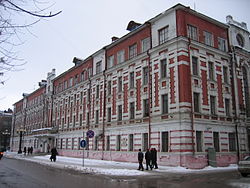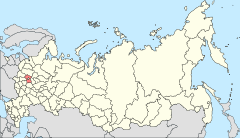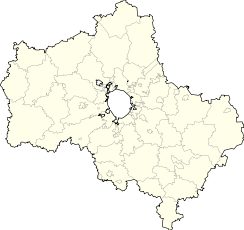- Orekhovo-Zuyevo
-
Orekhovo-Zuyevo (English)
Орехово-Зуево (Russian)- City[citation needed] - 
Orekhovo-Zuyevo Old Administration building
Location of Moscow Oblast in RussiaCoordinates: 55°48′N 38°58′E / 55.8°N 38.967°ECoordinates: 55°48′N 38°58′E / 55.8°N 38.967°E Coat of arms Flag Administrative status Country Russia Federal subject Moscow Oblast Municipal status Urban okrug Orekhovo-Zuyevo Urban Okrug[citation needed] Head[citation needed] Oleg Aparin[citation needed] Statistics Area 36 km2 (14 sq mi)[citation needed] Population (2010 Census,
preliminary)120,620 inhabitants[1] - Rank in 2010 135th Population (2002 Census) 122,248 inhabitants[2] - Rank in 2002 134th Density 3,351 /km2 (8,680 /sq mi)[3] Time zone MSD (UTC+04:00)[4] Founded 1917[citation needed] Postal code(s) 142600—142619[citation needed] Dialing code(s) +7 496[citation needed] Official website Orekhovo-Zuyevo (Russian: Оре́хово-Зу́ево) is an industrial city in Moscow Oblast, Russia, located 85 kilometers (53 mi) east of Moscow. It is situated in a forested area on the Klyazma River (a tributary of the Oka). The city was established in 1917 when three villages (Orekhovo, Zuyevo, and Nikolskoye) were merged, hence its name. Population: 120,620 (2010 Census preliminary results);[1] 122,248 (2002 Census);[2] 137,198 (1989 Census).[5]
Contents
History
The first facts about Orekhovo-Zuyevo date back to 1209. The place was mentioned in Moscow Chronicles as the place called "Volochok" where the battle between Valdimir's prince Yury and Ryazan's prince Izyaslav took place. The name "Volochok" (or as it was later called "Zuyev Volochok") is derived from the slavic word for a place where wooden ships were carried by land from one river to the other. In this place in particular, the ships were usually moved by land between rivers Klyazma and Nerskaya.
The villages Orekhovo and Zuyevo were mentioned in the chronicle a few more times in the Middle Ages.
In 1797, serf peasant Savva Morozov opened his first silk factory in Zuyevo. Later he shifted from silk to wool. In 1823, profits from his business allowed him to get out of serfdom. In 1830, he moved his factories to the other bank of the Klyazma River to the place that was later named Nikolskoye.
At the end of 19th and the beginning of the 20th centuries, Orekhovo-Zuyevo was the third largest textile city in Russia after Moscow and St. Petersburg.
In 1885, the Morozov's textile factories in Orekhovo-Zuyevo were the place of the first and largest Russian strike. It started on January 7, 1885 and lasted for several weeks. The impact of this strike on the revolutionary movement in Russia was tremendous.
Orekhovo-Zuyevo was granted town status in 1917.
Industry
For almost two centuries, Orekhovo-Zuyevo was mostly a textile industry oriented city. It in fact grew up around Savva Morozov's textile production. Cotton production in Orekhovo-Zuyevo made the city the third largest industrial center in Russia at the turn of the 20th century. After the communist revolt of 1917, Morozov's textile mills were nationalized. During the Soviet era they were known as "Orekhovo-Zuyevskiy Khlopchato-Bumazhnyy Kombinat" (Orekhovo-Zuyevo Cotton Center). The textile production existed only until the 1990s, when after the collapse of the Soviet Union Russian textile industry died due to economic difficulties, inability to compete with cheaper and better imported textiles, and poor management. Eventually, almost all production was shut down, and the factory halls were turned into market areas and trading centers.
Sports
Association football
The city is the home of the oldest association football team in Russia. The first football team in Orekhovo-Zuyevo was organized by British G.G. Charnock, who at that time was the vice-president of the Moscow Football League. Throughout the team's history it played under several different names. In the early years it was known as "Morozovtsy" (named after Morozov family which woned the textile production in the city). During the Soviet era, the team played under name "Znamya Truda". After the collapse of the communist regime the team was purchased by Spartak (Moscow) and was one of Spartak's farm teams, known as "Spartak-Orekhovo". In 2003 the team changed it name back to "Znamya Truda".
The best performance for "Znamya Truda" was the USSR Cup finals in 1962 when "Znamya Truda" lost to "Shakhtar" (Donetsk) 0:2.
In 2007 football season, "Znamya Truda" plays in the Central Zone of the Second Division.
Gymnastics
Olympic medalist and Junior European champion Anna Pavlova was born in Orekhovo-Zuyevo.
Badminton
Orekhovo-Zuyevo is famous for its badminton school. The city usually hosts All-Russian badminton championships.
Sports facilities
There are three athletic/football stadiums in the city: "Znamya Truda", "Torpedo", and "Khimik".
Swimming complex "Neptun" is adjacent to the "Znamya Truda" stadium. The swimming pool has 25-meter lanes.
A new sport complex facility "Vostok" was opened in 2007 by Moscow Region governor Gromov.
International relations
Main article: List of twin towns and sister cities in RussiaTwin towns/sister cities
Orekhovo-Zuyevo is twinned with:
Famous people associated with Orekhovo-Zuyevo
- Ivan Babushkin — communist revolution activist, bolshevik lived in Orekhovo-Zuyevo
- Vladimir Bondarenko — Hero of Soviet Union, partisan
- Mikhail Biryukov - footballer
- Yakov Flier - pianist
- Venedikt Erofeyev - Russian writer
- Yury Kovalyov - footballer
- Leonid Krasin — soviet activist
- Yuri Kurnenin - football manager
- Savva Morozov — Russian textile producer
- Anna Pavlova - Russian gymnast, Olympic medalist
- Alexey Pichugin - YUKOS manager
- Viktor Sukhorukov - Russian Actor
- Korniliy (Titov) - Metropolitan bishop of the Old Rite Orthodox Church
- Valentin Yanin - historian
References
- ^ a b Федеральная служба государственной статистики (Federal State Statistics Service) (2011). "Предварительные итоги Всероссийской переписи населения 2010 года (Preliminary results of the 2010 All-Russian Population Census)" (in Russian). Всероссийская перепись населения 2010 года (All-Russia Population Census of 2010). Federal State Statistics Service. http://www.perepis-2010.ru/results_of_the_census/results-inform.php. Retrieved 2011-04-25.
- ^ a b Федеральная служба государственной статистики (Federal State Statistics Service) (2004-05-21). "Численность населения России, субъектов Российской Федерации в составе федеральных округов, районов, городских поселений, сельских населённых пунктов – районных центров и сельских населённых пунктов с населением 3 тысячи и более человек (Population of Russia, its federal districts, federal subjects, districts, urban localities, rural localities—administrative centers, and rural localities with population of over 3,000)" (in Russian). Всероссийская перепись населения 2002 года (All-Russia Population Census of 2002). Federal State Statistics Service. http://www.perepis2002.ru/ct/doc/1_TOM_01_04.xls. Retrieved 2010-03-23.
- ^ The value of density was calculated automatically by dividing the 2010 Census population by the area specified in the infobox. Please note that this value may not be accurate as the area specified in the infobox does not necessarily correspond to the area of the entity proper or is reported for the same year as the population.
- ^ Правительство Российской Федерации. Постановление №725 от 31 августа 2011 г. «О составе территорий, образующих каждую часовую зону, и порядке исчисления времени в часовых зонах, а также о признании утратившими силу отдельных Постановлений Правительства Российской Федерации». Вступил в силу по истечении 7 дней после дня официального опубликования. Опубликован: "Российская Газета", №197, 6 сентября 2011 г. (Government of the Russian Federation. Resolution #725 of August 31, 2011 On the Composition of the Territories Included into Each Time Zone and on the Procedures of Timekeeping in the Time Zones, as Well as on Abrogation of Several Resolutions of the Government of the Russian Federation. Effective as of after 7 days following the day of the official publication).
- ^ "Всесоюзная перепись населения 1989 г. Численность наличного населения союзных и автономных республик, автономных областей и округов, краёв, областей, районов, городских поселений и сёл-райцентров. (All Union Population Census of 1989. Present population of union and autonomous republics, autonomous oblasts and okrugs, krais, oblasts, districts, urban settlements, and villages serving as district administrative centers.)" (in Russian). Всесоюзная перепись населения 1989 года (All-Union Population Census of 1989). Demoscope Weekly (website of the Institute of Demographics of the State University—Higher School of Economics. 1989. http://demoscope.ru/weekly/ssp/rus89_reg.php. Retrieved 2010-03-23.
Categories:- Cities and towns in Moscow Oblast
Wikimedia Foundation. 2010.


